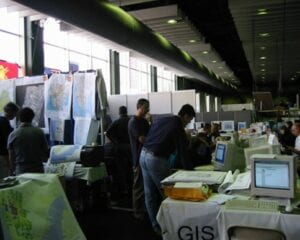NYC’s commitment to GIS mapping dates to the early 1980’s with the Department of City Planning’s development of a series of basemaps including citywide block, lot and centerline layers. Use of City Planning maps and spatial datasets resulted in significant GIS staff hiring. Many came together to form the Geospatial Information Systems and Mapping Organization (GISMO).
Next came the 9/11 attack on the World Trade Center. WTC Building 7, the location of NYC’s Emergency Operation Center, was set afire by burning debris resulting in the loss of consolidated data. GISMO leadership, including UNUM senior personnel Alan Leidner and Wendy Dorf, played an active role asking its members to volunteer mapping services. An instance of the emergency operation center was propped up on pier 92 and was staffed with 75+ GIS technicians from city, state, and federal agencies working 24/7 for 6 weeks. They produced 3,000+ maps and data products to support search and rescue operations, find locations for construction cranes, identify damage to underground infrastructure, fight underground fires, and locate airplane debris.

Although many lessons were learned, the key insight was that spatially enabled and interoperable data is essential for disaster preparedness and response. Since then, NYC’s enterprise GIS system has matured – supporting an ever-expanding set of use cases. However, little progress has been made on underground infrastructure mapping due to data sharing and security issues.
The UNUM project, with its many stakeholders will show the full viability of this from a security and data interoperability perspective. In recognition that this is a problem not just for NYC but for most communities, the Open Geospatial Consortium (OGC) initiated a Concept Development Study in 2017 aimed at identifying how best to standardize underground utility infrastructure data (i.e. water, sewer, electric, gas, telecommunications, thermal systems, and transit networks). That vision resulted in the creation of the Model for Underground Data Development and Integration (MUDDI) as overseen by OGC. More can be read about MUDDI here.
Despite sustained efforts since the 9/11 WTC attack, the vision of a unified subsurface resource with integrated stakeholder engagement has not materialized. Representatives of various NYC agencies, utilities and UNUM’s members have worked ceaselessly and enthusiastically towards this goal through workshops and related events over the past 3 years. UNUM would galvanize those efforts by providing resources for the 45 signed stakeholders to implement collectively and evaluate objectively a data sharing model in two demographically and economically distinctive neighborhoods to better manage increasing natural hazard vulnerability, as well as to support, large-scale, underground infrastructure dependent redevelopment in both areas.
